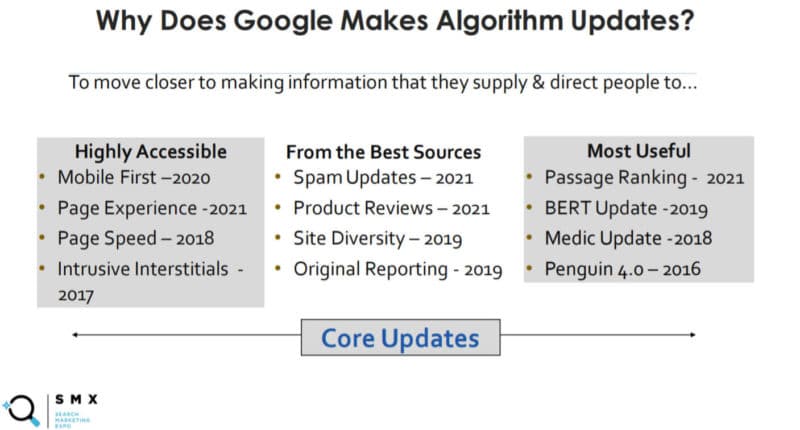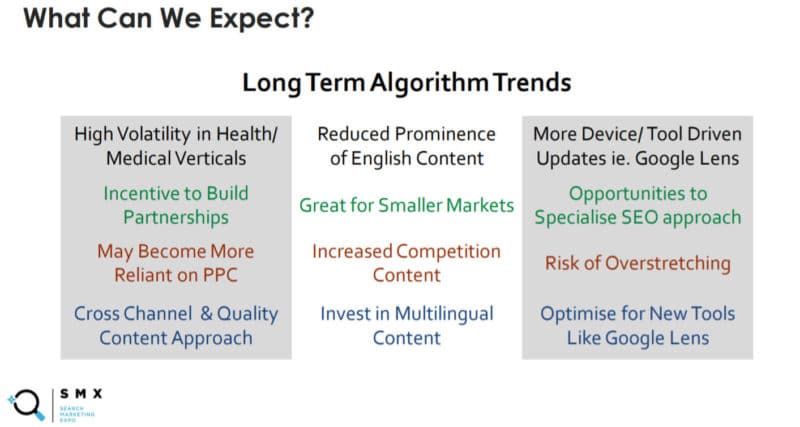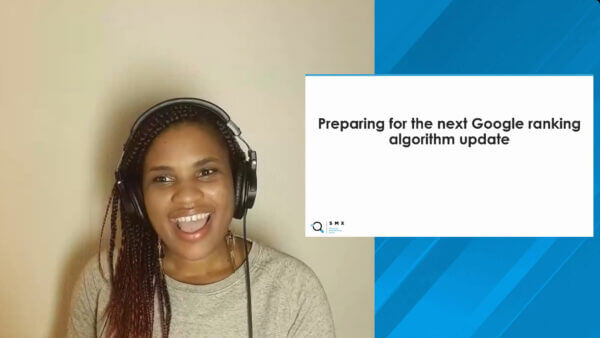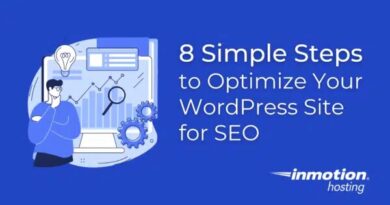How marketers can prepare for and respond to Google’s algorithm updates
Google updates its algorithms all the time, which leaves many marketers playing catch-up. At SMX Next, Crystal Carter shared how to be proactive when facing these changes.
“Google periodically adjusts what types of information it deems to be most important, which can sometimes have a big effect on which results are shown on the web,” said Crystal Carter, senior digital strategist at Optix Solutions, during her session at SMX Next.
Many marketers believe Google primarily relies on websites when creating and deploying each succeeding batch of algorithm updates. But, to improve searchers’ experiences, it actually focuses more on entities — a thing or concept that is singular, unique, well-defined and distinguishable, according to Google.
“Websites are important to Google, but that’s not the only way that it organizes information,” she said. “This is important for thinking about why and how Google makes updates.”

The information landscape is always growing, says Carter, and Google uses a variety of sources to present the most relevant results: “Google’s algorithms are taking into account where the search is made, where the information is coming from when the search is made and when the information was written. They also look at how the person is searching, whether they’re on their phone or their smartwatch or their smart refrigerator, as well as who wrote the content.”
“When we look at their algorithm updates, they’re essentially trying to direct people to highly accessible information from the best sources,” she added.
What happens during Google algorithm updates
Many Google algorithm updates address specific issues relating to an industry or SERP feature. These are usually easy to spot.
“When there’s a targeted update, which is my term and not Google’s, you’re likely to see changes to SERP features,” Carter said.
Carter calls these updates “targeted” because they usually focus on updating specific features of the SERP, such as how results are displayed and which sites are preferred for queries.

“If you look up a COVID testing site, you’ll see some of the targeted work that it’s [Google] done around that SERP,” she provided as an example of a “targeted” update, “It’s curated the results so that you’re seeing information from the government rather than seeing commercial results, and the maps that it’s showing are specifically targeted at medical elements.”
Core updates, on the other hand, are algorithm changes that alter how Google indexes and ranks sites broadly. These usually occur less frequently, but their impact can be enormous.
“Generally speaking, you might see changes to the types of domains which show in the SERPs,” Carter said. “You may see a sudden increase or decrease in domain visibility or a sudden increase or decrease in traffic across the domain.”
“So, rather than one page suddenly falling in rank, you might see a lot of pages change or increase in rank,” she added.
Identifying what type of algorithm update place took place is the first step in responding to ranking fluctuations. This allows marketers to plan a strategy that best addresses the issue.
How marketers should respond to updates
How you respond to a Google update not only depends on what type of change occurred but also on how it affected your online properties as well.
“If you’re on the winning end of this, it’s all smiles,” said Carter. “This is a good sign that you are on the right track with regards to the quality of your information, the demonstrable credibility of your website, and that Google thinks that you have good technical accessibility.”
“Doing well on Google algorithm updates gives you the opportunity to build and compound your SEO capabilities over time,” she added.

Yet when things don’t go as planned with these updates, brands often find themselves scrambling for solutions. This is when it helps to pinpoint the root cause, which can take many forms.
“One of the reasons is that the criteria for your vertical may have changed,” Carter said, referencing a former client who was negatively affected by Google’s update to medical-related results: “They were a reputable, fantastic medical business, and they were selling a test server health test. Then there was a change in the SERP — Google decommercialized this service. For that particular query, they were prioritizing people like the Mayo Clinic, the World Health Organization and the CDC.”
“When Google does that, you have to take a strategic approach to your SEO, which is different from your standard competitive keyword research,” she added.
Although verticals can change often, there’s also a good chance the SERP visibility drop was caused by a problem with your own properties.
“You might have missed something, and this often happens with in-house teams because you’re busy,” Carter said. “You might have missed a particular directive or instruction or rule, or a new element from Google. It might be that you need to play catch up.”
When your site is hit by a core update, it’s important to stay focused on best practices. Carter says this will future-proof your properties for the next round of changes.
“Don’t argue with the algorithm and don’t expect improvements until the next update,” she said. “Sometimes people want to throw everything at it. But generally speaking, the core of the core algorithm updates are around the domain, so Google makes it a quality assessment of your approach to SEO.”

What to expect from future changes
Successful marketing strategies don’t simply identify and respond to algorithm changes — they’re able to expect the trends shaping future updates. And from what many SEOs can tell, Google seems to be leaning more into AI modeling.
“Google introduced MUM [Multitask Unified Model] — the latest powerful AI tool and it helps it [Google] understand the information in a way that it’s not been able to do so before,” said Carter. “Not only does it process natural language, but it does so in 75 languages, and it’s also able to process text and also images and it’s also going to set up to be able to grow to process video and audio as well, so Google is already future-proofing this AI tool.”
“What we’re likely to see in the short term is more AI-powered large-scale updates,” she added.

The more Google leans into these models, the more marketers will need to stay on top of their online assets. And that means keeping them in tip-top shape — all the time. It’s the best way to prepare for whatever comes next.
“If you’re thinking about how to prepare for it,” Carter said, “I would say it’s worth making sure that your site is healthy all the time. Make sure that you have good, quality content rolling out in a consistent manner.”



